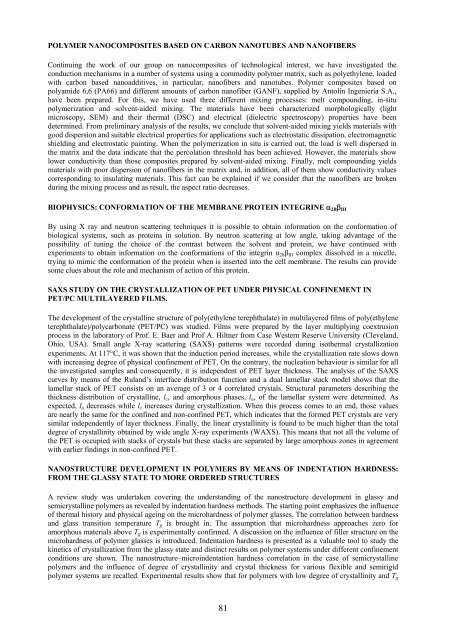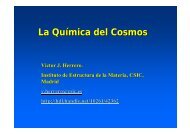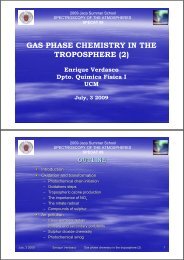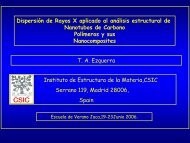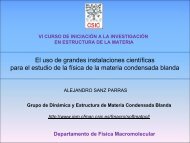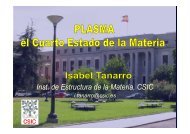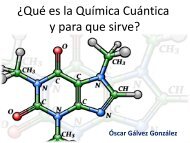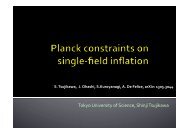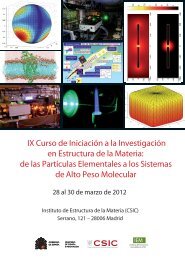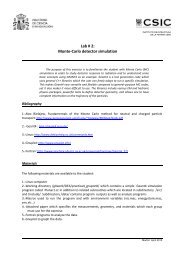memoria de 2009 - Instituto de Estructura de la Materia - Consejo ...
memoria de 2009 - Instituto de Estructura de la Materia - Consejo ...
memoria de 2009 - Instituto de Estructura de la Materia - Consejo ...
You also want an ePaper? Increase the reach of your titles
YUMPU automatically turns print PDFs into web optimized ePapers that Google loves.
POLYMER NANOCOMPOSITES BASED ON CARBON NANOTUBES AND NANOFIBERS<br />
Continuing the work of our group on nanocomposites of technological interest, we have investigated the<br />
conduction mechanisms in a number of systems using a commodity polymer matrix, such as polyethylene, loa<strong>de</strong>d<br />
with carbon based nanoadditives, in particu<strong>la</strong>r, nanofibers and nanotubes. Polymer composites based on<br />
polyami<strong>de</strong> 6,6 (PA66) and different amounts of carbon nanofiber (GANF), supplied by Antolin Ingeniería S.A.,<br />
have been prepared. For this, we have used three different mixing processes: melt compounding, in-situ<br />
polymerization and solvent-ai<strong>de</strong>d mixing. The materials have been characterized morphologically (light<br />
microscopy, SEM) and their thermal (DSC) and electrical (dielectric spectroscopy) properties have been<br />
<strong>de</strong>termined. From preliminary analysis of the results, we conclu<strong>de</strong> that solvent-ai<strong>de</strong>d mixing yields materials with<br />
good dispersion and suitable electrical properties for applications such as electrostatic dissipation, electromagnetic<br />
shielding and electrostatic painting. When the polymerization in situ is carried out, the load is well dispersed in<br />
the matrix and the data indicate that the perco<strong>la</strong>tion threshold has been achieved. However, the materials show<br />
lower conductivity than those composites prepared by solvent-ai<strong>de</strong>d mixing. Finally, melt compounding yields<br />
materials with poor dispersion of nanofibers in the matrix and, in addition, all of them show conductivity values<br />
corresponding to insu<strong>la</strong>ting materials. This fact can be exp<strong>la</strong>ined if we consi<strong>de</strong>r that the nanofibers are broken<br />
during the mixing process and as result, the aspect ratio <strong>de</strong>creases.<br />
BIOPHYSICS: CONFORMATION OF THE MEMBRANE PROTEIN INTEGRINE 2B III<br />
By using X ray and neutron scattering techniques it is possible to obtain information on the conformation of<br />
biological systems, such as proteins in solution. By neutron scattering at low angle, taking advantage of the<br />
possibility of tuning the choice of the contrast between the solvent and protein, we have continued with<br />
experiments to obtain information on the conformations of the integrin α 2b β III complex dissolved in a micelle,<br />
trying to mimic the conformation of the protein when is inserted into the cell membrane. The results can provi<strong>de</strong><br />
some clues about the role and mechanism of action of this protein.<br />
SAXS STUDY ON THE CRYSTALLIZATION OF PET UNDER PHYSICAL CONFINEMENT IN<br />
PET/PC MULTILAYERED FILMS.<br />
The <strong>de</strong>velopment of the crystalline structure of poly(ethylene terephtha<strong>la</strong>te) in multi<strong>la</strong>yered films of poly(ethylene<br />
terephtha<strong>la</strong>te)/polycarbonate (PET/PC) was studied. Films were prepared by the <strong>la</strong>yer multiplying coextrusion<br />
process in the <strong>la</strong>boratory of Prof. E. Baer and Prof A. Hiltner from Case Western Reserve University (Cleve<strong>la</strong>nd,<br />
Ohio, USA). Small angle X-ray scattering (SAXS) patterns were recor<strong>de</strong>d during isothermal crystallization<br />
experiments. At 117C, it was shown that the induction period increases, while the crystallization rate slows down<br />
with increasing <strong>de</strong>gree of physical confinement of PET. On the contrary, the nucleation behaviour is simi<strong>la</strong>r for all<br />
the investigated samples and consequently, it is in<strong>de</strong>pen<strong>de</strong>nt of PET <strong>la</strong>yer thickness. The analysis of the SAXS<br />
curves by means of the Ru<strong>la</strong>nd’s interface distribution function and a dual <strong>la</strong>mel<strong>la</strong>r stack mo<strong>de</strong>l shows that the<br />
<strong>la</strong>mel<strong>la</strong>r stack of PET consists on an average of 3 or 4 corre<strong>la</strong>ted crystals. Structural parameters <strong>de</strong>scribing the<br />
thickness distribution of crystalline, l c , and amorphous phases, l a , of the <strong>la</strong>mel<strong>la</strong>r system were <strong>de</strong>termined. As<br />
expected, l a <strong>de</strong>creases while l c increases during crystallization. When this process comes to an end, those values<br />
are nearly the same for the confined and non-confined PET, which indicates that the formed PET crystals are very<br />
simi<strong>la</strong>r in<strong>de</strong>pen<strong>de</strong>ntly of <strong>la</strong>yer thickness. Finally, the linear crystallinity is found to be much higher than the total<br />
<strong>de</strong>gree of crystallinity obtained by wi<strong>de</strong> angle X-ray experiments (WAXS). This means that not all the volume of<br />
the PET is occupied with stacks of crystals but these stacks are separated by <strong>la</strong>rge amorphous zones in agreement<br />
with earlier findings in non-confined PET.<br />
NANOSTRUCTURE DEVELOPMENT IN POLYMERS BY MEANS OF INDENTATION HARDNESS:<br />
FROM THE GLASSY STATE TO MORE ORDERED STRUCTURES<br />
A review study was un<strong>de</strong>rtaken covering the un<strong>de</strong>rstanding of the nanostructure <strong>de</strong>velopment in g<strong>la</strong>ssy and<br />
semicrystalline polymers as revealed by in<strong>de</strong>ntation hardness methods. The starting point emphasizes the influence<br />
of thermal history and physical ageing on the microhardness of polymer g<strong>la</strong>sses. The corre<strong>la</strong>tion between hardness<br />
and g<strong>la</strong>ss transition temperature T g is brought in. The assumption that microhardness approaches zero for<br />
amorphous materials above T g is experimentally confirmed. A discussion on the influence of filler structure on the<br />
microhardness of polymer g<strong>la</strong>sses is introduced. In<strong>de</strong>ntation hardness is presented as a valuable tool to study the<br />
kinetics of crystallization from the g<strong>la</strong>ssy state and distinct results on polymer systems un<strong>de</strong>r different confinement<br />
conditions are shown. The nanostructure–microin<strong>de</strong>ntation hardness corre<strong>la</strong>tion in the case of semicrystalline<br />
polymers and the influence of <strong>de</strong>gree of crystallinity and crystal thickness for various flexible and semirigid<br />
polymer systems are recalled. Experimental results show that for polymers with low <strong>de</strong>gree of crystallinity and T g<br />
81


